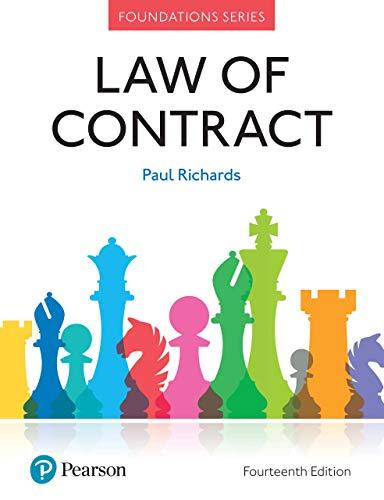Question
View the posted Hot Coffee video (click on the arrow in the box with the cup of coffee in it) and read the posted handout
View the posted "Hot Coffee" video (click on the arrow in the box with the cup of coffee in it) and read the posted handout about the case (you should consider the sources . . .) This was a strict product liability case. There is plenty of disagreement (even among reasonable people) regarding this case. After doing a bit of research ( properly cite at least one other outside source), take a position on the following question and defend it.
https://www.upworthy.com/ever-hear-about-the-lady-that-spilled-coffee-on-herself-at-mcdonalds-then-sued-for-millions
https://www.youtube.com/watch?v=pCkL9UlmCOE&t=60s
- Was Liebeck v. McDonald's Restaurantsa frivolous or worthy lawsuit? Defend your position.
Explain in detail, please.
THE FACTS ABOUT THE MCDONALDS= COFFEE CASE There is a lot of hype about McDonald's' scalding coffee case.No one is in favor of frivolous cases of outlandish results; however, it is important to understand some points that were not reported in most of the stories about the case.McDonald's coffee was not only hot, it was scalding -- capable of almost instantaneous destruction of skin, flesh, and muscle.Here's the whole story. Stella Liebeck of Albuquerque, New Mexico, was in the passenger seat of her grandson's car when she was severely burned by McDonalds='s coffee in February 1992.Liebeck, 79 at the time, ordered coffee that was served in a styrofoam cup at the drive-through window of a local McDonalds. After receiving the order, the grandson pulled his car forward and stopped momentarily so that Liebeck could add cream and sugar to her coffee. (Critics of civil justice, who have pounced on this case, often charge that Liebeck was driving the car or that the vehicle was in motion when she spilled the coffee; neither is true.)Liebeck placed the cup between her knees and attempted to remove the plastic lid from the cup. As she removed the lid, the entire contents of the cup spilled into her lap. The sweatpants Liebeck was wearing absorbed the coffee and held it next to her skin.The avascular surgeon determined that Liebeck suffered full-thickness burns (or third-degree burns) over 6 percent of her body, including her inner thighs, perineum, buttocks, and genital and groin areas.She was hospitalized for eight days, during which time she underwent skin grafting. Liebeck, who also underwent debridement treatments, sought to settle her claim for $20,000, but McDonald's refused. During discovery, Mcdonald's produced documents showing more than 700 claims by people burned by its coffee between 1982 and 1992. Some claims involved third-degree burns substantially similar to Liebeck=s. This history documented McDonald's' knowledge about the extent and nature of this hazard. McDonald also said during discovery that, based on a consultant's advice, it held its coffee at between 180 and 190 degrees Fahrenheit to maintain optimum taste.He admitted that he had not evaluated the safety ramifications at this temperature.Other establishments sell coffee at substantially lower temperatures, and coffee served at home is generally 135 to 140 degrees. Further, McDonald's' quality assurance manager testified that the company actively enforces a requirement that coffee is held in the pot at 185 degrees, plus or minus five degrees.He also testified that a burn hazard exists with any food substance served at 140 degrees or above and that McDonald's coffee, at the temperature at which it was poured into styrofoam cups, was not fit for consumption because it would burn the mouth and throat.The quality assurance manager admitted that burns would occur, but testified that Mcdonald's had no intention of reducing the "holding temperature" of its coffee. Plaintiffs' expert, a scholar in thermodynamics applied to human skin burns, testified that liquids, at 180 degrees, will cause a full-thickness burn to human skin in two to seven seconds.Other testimony showed that as the temperature decreases toward 155 degrees, the extent of the burn relative to that temperature decreases exponentially.Thus, if Liebeck's spill had involved coffee at 155 degrees, the liquid would have cooled and given her time to avoid a serious burn.McDonald asserted that customers buy coffee on their way to work or home, intending to consume it there. However, the company=s own research showed that customers intend to consume the coffee immediately while driving. McDonald also argued that consumers know coffee is hot and that its customers want it that way.The company admitted its customers were unaware that they could suffer third-degree burns from the coffee and that a statement on the side of the cup was not a "warning" but a "reminder" since the location of the writing would not warn customers of the hazard. The jury awarded Liebeck $200,000 in compensatory damages.This amount was reduced to $160,000 because the jury found Liebeck 20 percent at fault in the spill.The jury also awarded Liebeck $2.7 million in punitive damages, which equals about two days of McDonald's' coffee sales. The post-verdict investigation found that the temperature of coffee at the local Albuquerque McDonalds had dropped to 158 degrees Fahrenheit. The trial court subsequently reduced the punitive award to $480,000 B or three times compensatory damages -- even though the judge called McDonald's' conduct reckless, callous, and willful. No one will ever know the final ending to this case. The parties eventually entered into a secret settlement which has never been revealed to the public, despite the fact that this was a public case, litigated in public, and subjected to extensive media reporting. Such secret settlements, after public trials, should not be condoned.----- excerpted from ATLA fact sheet. 81995, 1996 by Consumer Attorneys of California
Step by Step Solution
There are 3 Steps involved in it
Step: 1

Get Instant Access to Expert-Tailored Solutions
See step-by-step solutions with expert insights and AI powered tools for academic success
Step: 2

Step: 3

Ace Your Homework with AI
Get the answers you need in no time with our AI-driven, step-by-step assistance
Get Started


